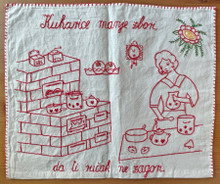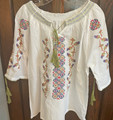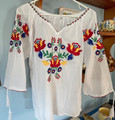 Loading... Please wait...
Loading... Please wait...Categories
New Products
-
$9.95$7.95 -
$7.99$6.49 -
$7.99$6.49 -
$69.00$49.95 -
$26.95$21.95
Our Newsletter
- Home
- COOKING & KITCHEN: Great Prices!
- ZIDNJAK (Hand-Embroidered Kitchen Wall Hanging), ONE-OF-A-KIND! "Cooks Say Less, So Your Lunch Doesn't Burn!" SOLD OUT!
Product Description
ZIDNJAK: "Embroidered Paintings" 24 in x 20 in
A "ZIDNJAK" (masonry) was usually placed on the wall, next to the beds, or next to the bench in the kitchen, and had a decorative role, but usually not a practical or useful role. If not hanging on the wall, then these hand-embroidered textiles with various phrases on them were kept in cupboards and chests. They are many times given as wedding gifts.
Masonry or wall cloths are embroidered white linen fabrics of various motifs and messages. They mostly found their place in kitchens next to stoves, when open fireplaces were replaced by closed stoves. A few decades ago, we found them in almost all country houses, and a little later in town homes. The most common motifs on the masonry dealt with kitchen and food themes, usually hung on the kitchen walls because the kitchen was the center of social events, family gatherings or meetings with guests. A special feature of the masonry were short, specific and witty messages that formed a whole with a visual motif, and from which one could read a lot about household members, family relationships, attitudes and the like.
At the time of the masonry, the flow of information was very slow, so the masonry should be perceived as a communication template of that time. Masonry would usually be sewn by women, most often in the winter when there was not so much outdoor work. Patterns and schemes were chosen according to their own choice because they would usually reflect some personalities or life situations in which the household members themselves, usually housewives, would find themselves.*
*from "Kuha Ona"













